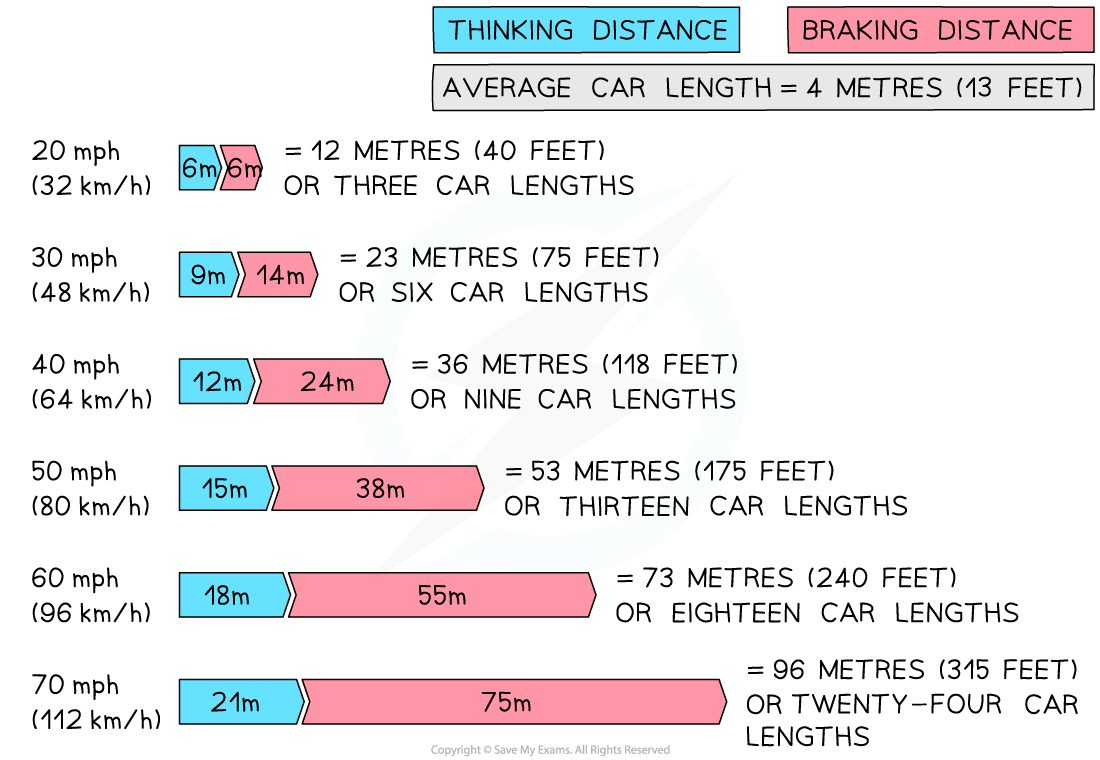Stopping Distance (Oxford AQA IGCSE Physics)
Revision Note

Author
Leander OatesExpertise
Physics
Stopping Distance
The stopping distance of a car is defined as:
The total distance travelled during the time it takes for a car to stop in response to some emergency
Stopping distance is the sum of the thinking distance and the braking distance
Stopping distance = Thinking distance + Braking distance
Thinking distance
Thinking distance is defined as:
The distance travelled in the time it takes the driver to react (reaction time) in metres (m)
The main factors affecting thinking distance are:
The speed of the car
The reaction time of the driver
The reaction time is defined as:
A measure of how much time passes between seeing something and reacting to it
The average reaction time of a human is 0.25 s
Reaction time is increased by:
Tiredness
Distractions (e.g. using a mobile phone)
Intoxication (i.e. consumption of alcohol or drugs)
Braking distance
Braking distance is defined as:
The distance travelled under the braking force in metres (m)
For a given braking force, the greater the speed of the vehicle the greater the stopping distance
The effect of speed on stopping distance

A Table Showing Speed and Stopping Distance
Speed (mph) | Speed (m/s) | Stopping Distances (m) |
20 | 9 | 12 |
30 | 14 | 23 |
40 | 18 | 36 |
50 | 22 | 53 |
60 | 27 | 73 |
Worked Example
At a speed of 20 m/s, a particular vehicle had a stopping distance of 40 metres. The car travelled 14 metres whilst the driver was reacting to the incident in front of them.
What was the braking distance?
A 54 m
B 34 m
C 26 m
D 6 m
Answer: C
Step 1: Identify the different variables
Stopping distance = 40 m
Thinking distance = 14 m
Step 2: Rearrange the formula for stopping distance
stopping distance = thinking distance + braking distance
braking distance = stopping distance – thinking distance
Step 3: Calculate and identify the correct braking distance
braking distance = 40 – 14
braking distance = 26 metres
Therefore, the answer is C
Worked Example
The graph below shows how the thinking distance of a driver depends on the speed of the car.

(a) Use the graph to describe the relationship between thinking distance and speed.
(b) Some people drive when they are tired, despite warnings against doing so.
Draw a new line on the graph to show how thinking distance varies with speed for a tired driver.
Answer:
Part (a)
Step 1: Check if the line is straight and if it goes through the origin
The graph shows a straight line through the origin
Therefore, the thinking distance is directly proportional to the speed of the car
Part (b)
Step 1: Recall the factors which affect the thinking distance
Three additional factors affect the thinking distance because they affect human reaction time:
Tiredness
Distractions
Intoxication
Hence, a tired driver's reaction time is greater (i.e. it takes longer for them to react)
Step 2: Draw a line that shows greater thinking distance for the same speed
At the same speed, a tired driver's thinking distance will be greater than a driver who is alert
This means a line should be drawn with a steeper gradient, as shown below

Factors Affecting Braking Distance
The main factor affecting the braking distance of a car is its speed
There are additional factors which affect the braking distance, such as:
Vehicle condition - e.g. worn tyres or poor brakes
Road condition - wet or icy roads make it harder to decelerate
Vehicle mass - a heavy vehicle, such as a lorry, takes longer to stop

You've read 0 of your 0 free revision notes
Get unlimited access
to absolutely everything:
- Downloadable PDFs
- Unlimited Revision Notes
- Topic Questions
- Past Papers
- Model Answers
- Videos (Maths and Science)
Did this page help you?